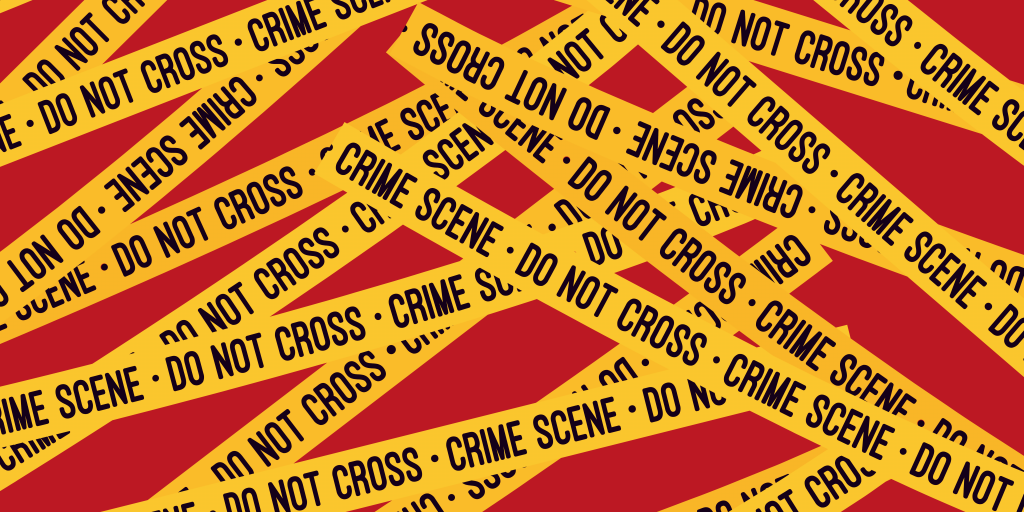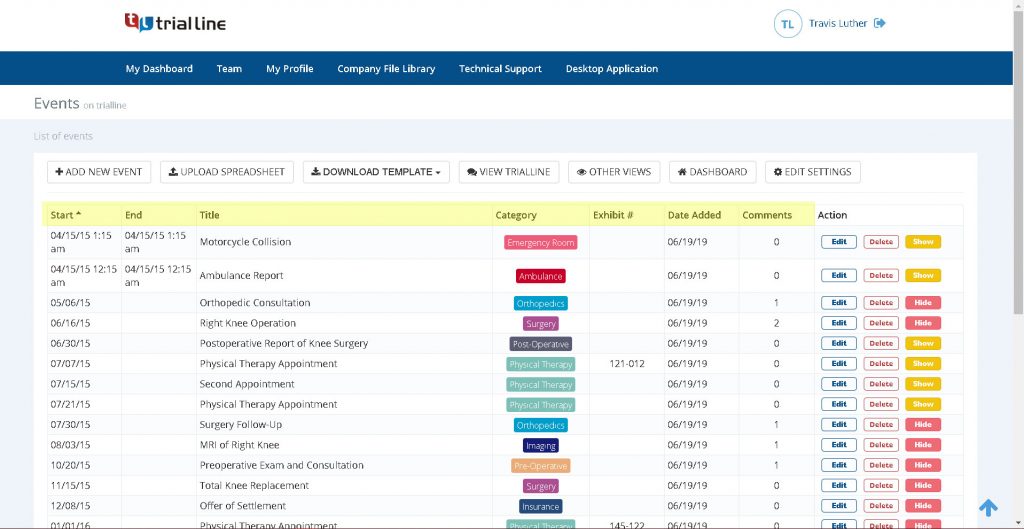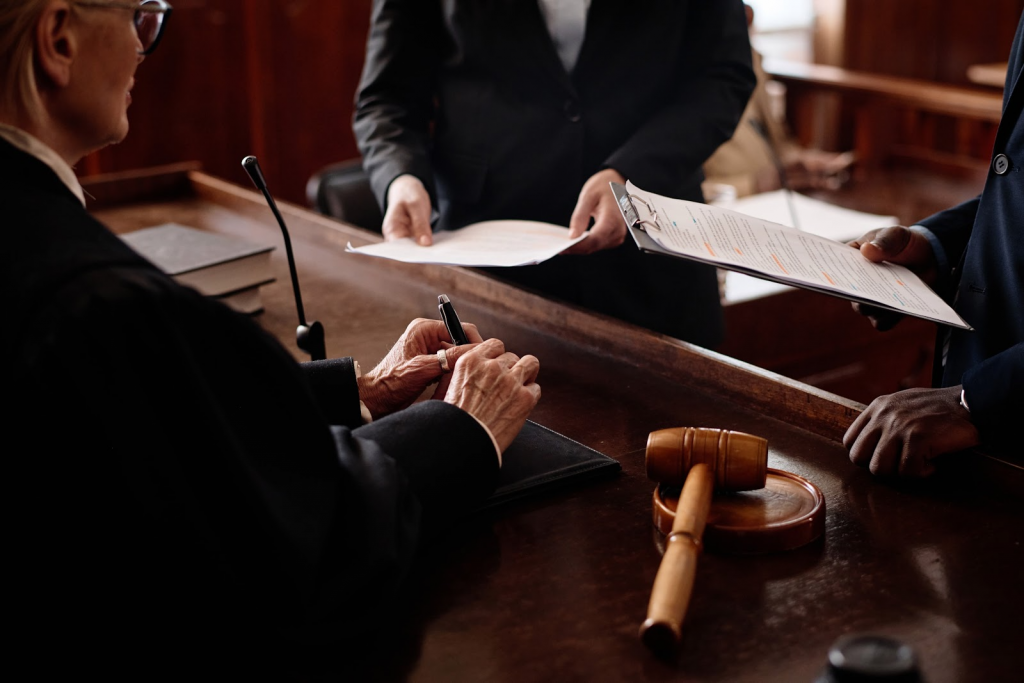The criminal investigation timeline is a comprehensive document that maps the incident sequence from the crime scene to the trial.
More than a record, this timeline format is a tool for law enforcement agencies and defense teams. It supports thorough investigation while identifying inconsistencies and establishing reasonable doubt.
In this article, we explain the stages of the criminal investigation timeline and what’s involved. We also discuss how tools like TrialLine offer a simple and convenient way for attorneys to establish legal timelines.
Start using TrialLine today! Create a more effective, data-driven approach to case management.
What is an Investigation Timeline?
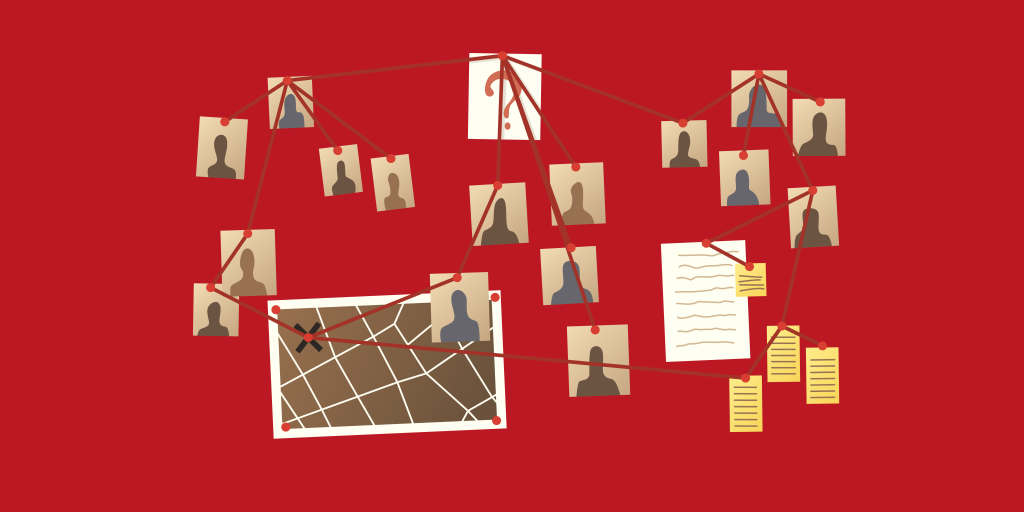
A criminal investigation timeline is a chronological reconstruction of events and actions in a case. It’s mapped using witness accounts, forensic analyses, and procedural steps. This involved process structures key events along a date and time scale so investigators can begin organizing details and formulating initial theories.
Every timeline review refines initial theories, supports the written report, and strengthens the investigation process. Whether analyzing different causal paths or organizing data in objective straight-line order, one comprehensive timeline keeps everything in check.
Attorneys who are involved can then build a more complete explanation of the case. You can identify patterns and inconsistencies that can establish reasonable doubt in court. It also strengthens communication among investigative teams.
Recommended Reading
Case Timeline Software for Different Legal Specializations
Stages of Criminal Investigation
A criminal investigation timeline follows a structured process, so all evidence is gathered, analyzed, and presented accurately. Each stage contributes to identifying suspects and building a strong case.
1. Crime Occurrence and Initial Response
The criminal investigation begins as soon as a crime is reported. Prompt action from law enforcement preserves key evidence and helps investigators organize details for a thorough case review.
In this stage, proper documentation of the date and time scale and initial witness accounts are done to construct an accurate sequence of events.
Reporting the Crime
Crimes can be reported by victims, witnesses, or law enforcement officers. Immediate reporting helps authorities formulate initial theories and determine the next steps. The timeline explains how early documentation of the incident sequence can support a clear investigative framework.
Initial Law Enforcement Response
Once officers arrive at the scene, their priority is securing the area and maintaining safety. They conduct preliminary interviews and gather witness statements to establish what happened.
If necessary, medical attention is provided to victims and bystanders. Officers then shift their focus to gathering crucial details by interviewing victims, witnesses, and anyone else present who might have valuable information.
2. Crime Scene Investigation
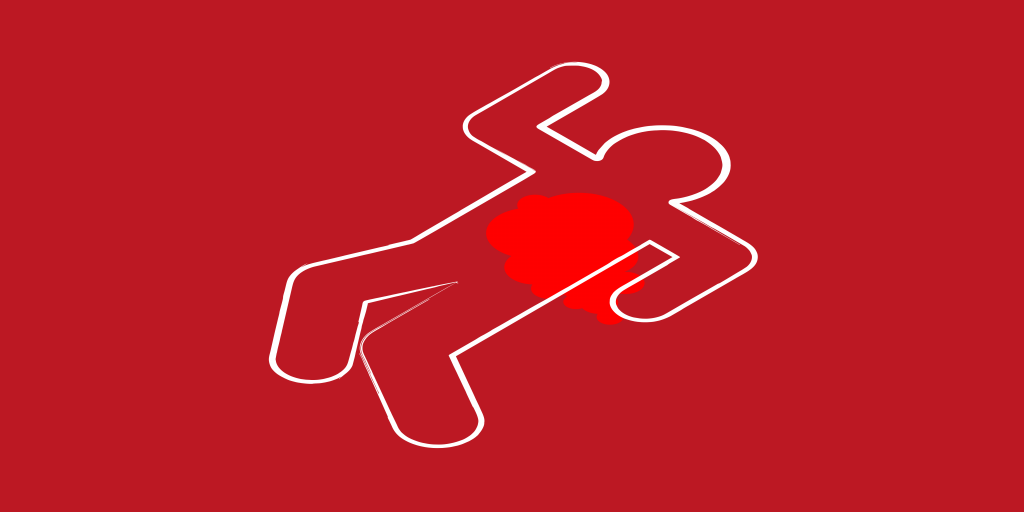
A well-preserved crime scene provides investigators with evidence to reconstruct the crime. This stage maintains the integrity of physical evidence for forensic analysis.
Securing the Crime Scene
Officers establish a controlled perimeter to prevent contamination. Proper scene security helps maintain a clear chain of evidence, ensuring findings remain admissible in court. This process is necessary for a more complete explanation of the crime.
Evidence Collection
Crime Scene Investigators (CSIs) search for fingerprints, DNA, weapons, and other critical items. Every piece of evidence is documented, photographed, and logged for accuracy.
This step strengthens the criminal investigation timeline and connects the evidence to specific moments.
Initial Analysis
CSIs analyze patterns in the crime scene, such as:
- Points of entry
- Possible struggle indicators
- Suspect movements
Their observations help formulate initial theories and guide the next steps in the investigation.
3. Investigation Phase
Once the crime scene is processed, detectives begin analyzing evidence, conducting interviews, and developing hypotheses. This phase focuses on identifying suspects and piecing together key details.
Formulating Hypotheses
Investigators review the following to create a logical narrative of the crime:
- CSI reports
- Witness statements
- Physical evidence
They start formulating hypotheses about what transpired, weaving a logical narrative that explains the crime based on all available information. They consider questions such as: Is there a clear motive? Do the witness accounts and physical evidence align?
By scrutinizing every detail, investigators aim to build a solid foundation for their case, one that can withstand potential challenges.
Follow-up Interviews
Additional interviews with victims, witnesses, and suspects help clarify earlier statements. Investigators use questioning techniques to detect deception, confirm facts, and uncover new leads. The timeline explains how interviews shape the case’s direction.
Background Checks
To get a more complete picture, investigators delve into the backgrounds of suspects and anyone else who might be relevant to the case.
A section labeled background information includes the suspect’s history, relationships, and past criminal activity. This review helps eliminate false leads and establish motive, adding depth to the criminal investigation timeline.
Surveillance and Undercover Operations
When necessary, investigators may employ surveillance or undercover operations to gather additional evidence. This can involve monitoring suspects’ activities, planning undercover agents, or using technology to track movements and communications.
Enhance your investigations with TrialLine. Try it free for 14 days!
4. Forensic Analysis
Scientific examination of evidence provides definitive links between suspects, victims, and crime scenes. Forensic findings help confirm guilt or establish reasonable doubt.
Laboratory Examination
Collected evidence travels to forensic laboratories for examination. Here, specialists conduct a range of tests like DNA analysis, ballistics to study projectiles, toxicology to identify poison, and other specialized procedures.
These analyses are crucial for forensic experts to build connections between suspects, victims, and the crime scene itself.
Digital Forensics
With digital devices becoming integral to daily life, digital forensics has introduced a new dimension to criminal investigation.
Experts examine electronic devices such as computers, smartphones, and networks, uncovering hidden evidence like emails, messages, and browsing history that can shed light on a crime.
5. Arrest and Charges
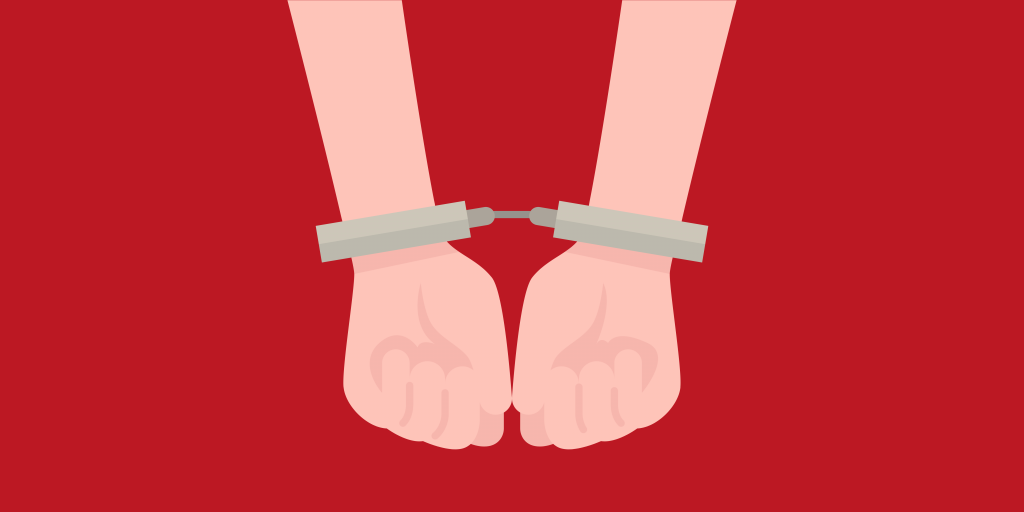
Once sufficient evidence is collected, law enforcement moves forward with detaining suspects and formally charging them with a crime.
Establishing Probable Cause
Before making an arrest, investigators must gather enough evidence to demonstrate that the suspect is likely responsible.
This means gathering enough evidence, whether physical objects, witness accounts, or findings from their investigation, to convince a reasonable person that the suspect is linked to the crime.
Making the Arrest
With probable cause secured, law enforcement moves to make the arrest. The suspect is apprehended, informed of their Miranda rights, and enters the criminal justice system.
Filing Charges
Following the arrest, prosecutors dissect the evidence to craft appropriate charges. They draft formal accusations and present them in court, ensuring the case is trial-ready, and the evidence backs their arguments.
6. Pre-Trial Activities
Once charges are filed, the legal process begins. Both the prosecution and defense prepare their arguments for a fair trial.
Arraignment
The suspect appears in court and hears the formal charges. They enter a plea of guilty, not guilty, or no contest. At this stage, the judge may also set bail conditions. The judge also establishes a timeline for future court hearings.
Discovery Process
The prosecution and defense exchange evidence so both sides can assess key details. Both sides dissect the information to build their cases, ensuring a fair trial where each party has had a chance to examine all relevant material.
Pre-Trial Motions
Before the trial unfolds, attorneys can deploy pre-trial motions to tackle legal hurdles. These motions might aim to suppress questionable evidence, dismiss charges altogether, or even shift the trial location.
The judge weighs the legal arguments and case specifics before issuing a ruling.
7. The Trial
The prosecution and defense present their arguments, and the jury or judge makes the final decision.
Jury Selection
The trial process unfolds with jury selection. Lawyers on both sides grill potential jurors in a process called voir dire, searching for bias and warding off anyone who might not be impartial to seat a fair and unbiased jury.
Opening Statements
Both sides outline their cases, explaining their key arguments and the evidence they plan to present.
The prosecution presents witness testimony, forensic reports, and physical evidence to prove the defendant’s guilt. The defense counters with the evidence and arguments to challenge the prosecution’s case.
Closing Arguments
With the evidence presented, the stage is set for closing arguments. Here, both sides unleash their most persuasive weapons, summarizing their cases and highlighting the strengths of their evidence and the weaknesses of their opponent’s arguments. It’s a final push to sway the jury.
Jury Deliberation and Verdict
The jury deliberates in private to reach a verdict. They analyze the evidence and arguments presented throughout the trial. Their ultimate challenge is to reach a unanimous verdict, convicting or acquitting the defendant.
If a unanimous decision proves elusive, a hung jury may result, potentially leading to a retrial.
8. Post-Trial Activities
Following the trial, sentencing and potential appeals determine the outcome of the case.
Sentencing
If the defendant is found guilty, the judge determines an appropriate sentence based on the factors like:
- Severity
- Legal guidelines
- Mitigating circumstances
Their decision determines the punishment – ranging from fines and probation to incarceration or, in rare cases, capital punishment.
Appeals
If the defense believes errors were made during the trial, they can appeal the conviction. An appellate court reviews the trial record to determine whether a new trial or reduced sentence is warranted.
Post-Conviction Relief
Defendants may seek legal remedies if:
- New evidence emerges
- They received ineffective legal counsel
- Their rights were violated
The court evaluates these claims to determine if relief is justified.
Recommended Reading
How Legal Timeline Software Can Streamline Immigration Case Management
Create a Criminal Investigation Timeline with TrialLine
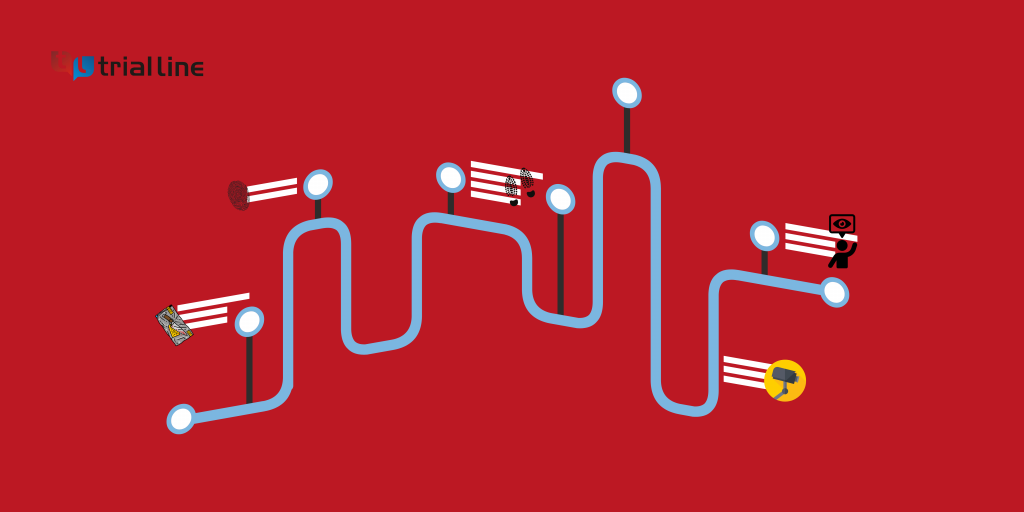
Piecing together the timeline of a criminal investigation using legal timeline software can improve efficiency and case clarity. Just a few lines in a structured timeline can help track key events, evidence, and witness statements.
TrialLine offers multimedia integration and a user-friendly interface. You can gather all materials, including forensic reports and digital data, and then categorize and attach them to relevant events.
You can also create a visual timeline with full-screen access for detailed analysis. Law enforcement and legal teams can identify patterns, connections, and inconsistencies while collaborating in real time.
Sign up for a 7-day free trial or schedule a demo to get hands-on experience building effective timelines.
FAQs About Investigation Timeline
What is the timeline of an investigation?
It is a chronological record of events, evidence, and actions taken during a case. It helps law enforcement and legal teams track progress, connect evidence, and ensure a structured approach from the crime report to trial.
How long does a typical investigation take?
The length of an investigation varies based on complexity, available evidence, and legal procedures. Some cases are resolved in weeks, while others take months or years.
What are the 7 steps of an investigation?
The key steps include crime occurrence and response, crime scene investigation, evidence collection, suspect identification, arrest and charges, pre-trial proceedings, and trial and sentencing. Each step ensures a thorough and legal process.
How can I create a timeline for an investigation?
Gather all relevant evidence, organize events chronologically, and use legal timeline software like TrialLine to visualize events, track details, and improve case management.
Why is creating a timeline important in an investigation?
A well-constructed timeline provides a clear sequence of events, helping investigators identify patterns, establish cause-and-effect relationships, and detect inconsistencies. It serves as a foundational tool to organize information and guide the investigative process.

